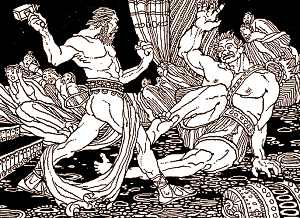A Marriage Made in Heaven:
Thor as the Bride of Thrym
by Peter Krüger
©2014
[Germanic Astronomy]
.jpg)
Thrymskvida, the story of how Thor’s hammer Mjöllnir was stolen by the giant (thurs) Thrym and how he rescued it by disguising himself as a bride pretending to be Freyja and finally smashing Thrym with his hammer, is one of the most famous Eddic poems. It seems to be one of the oldest poems handed down to us. Nevertheless it puzzled scholars due to its content. Most see it as a genuine pre-christian poem, whereas others suspect it to be a christian parody as they find it hard to believe that one of the highest Germanic gods would have allowed himself to be dressed as a bride. See the Thrymskvida Study Guide for details.
In the case of Thrymskvida, it may be fruitful to assume an astral background of the Eddic story. As I already discussed in the essay Mjöllnir – Thor’s short handled hammer it seems to be possible to connect the hammer Mjöllnir with the asterism of the Pleiades, a part of the constellation Taurus. Indeed this asterism has the shape of a hammer with a short handle. Therefore in an astronomical context the poem would describe how the asterism of the Pleiades disappears at the western horizon and how it reappears in the east.
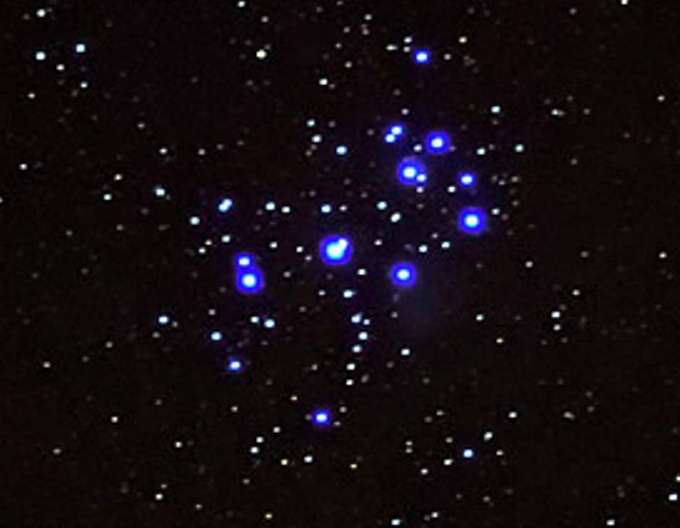 Aratus' Phaenomena describes them thus: [253] ...the Pleiades, all in a cluster, but small is the space that holds them and singly they dimly shine. Seven are they in the songs of men, albeit only six are visible to the eyes. Yet not a star, I ween, has perished from the sky unmarked since the earliest memory of man, but even so the tale is told. Those seven are called by name Halcyone, Merope, Celaeno, Electra, Sterope, Taygete, and queenly Maia. Small and dim are they all alike, but widely famed they wheel in heaven at morn and eventide, by the will of Zeus, who bade them tell of the beginning of Summer and Winter and of the coming of the ploughing-time.” |
There is one detail that supports the interpretation that the poem describes the motion of the Pleiades as they disappear on the western horizon and how they reappear in the east:
After Thor recognizes that his hammer has been stolen he sent out Loki to search for it. For this purpose Loki borrows Freyja's falcon-cloak and flies east in search of it. Interestingly Freyja is the Germanic counterpart of the Greek goddess-of-love Aphrodite and there is a Greek star lore (the Nemesis/Leda myth) where Aphrodite appears in the shape of an eagle, the constellation Aquila. It therefore seems possible to assume that Loki appears in Thrymskvida as the constellation Aquila. Indeed Aquila appears approximately at the time of the setting of the Pleiades, so there is a perfect fit with the Old Norse myth.
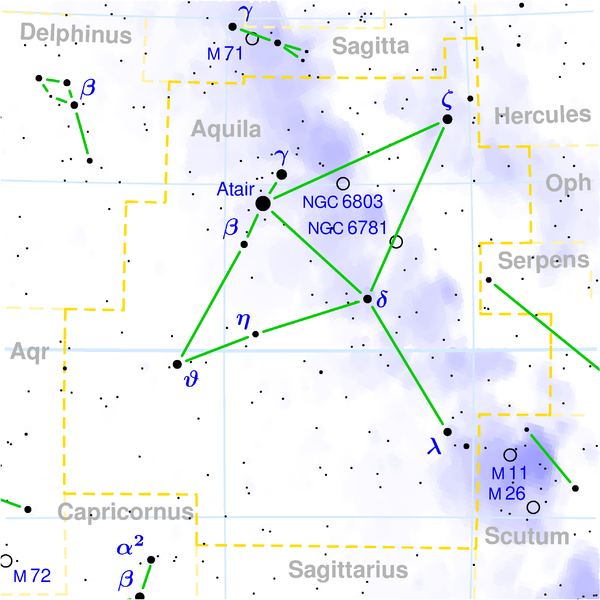 |
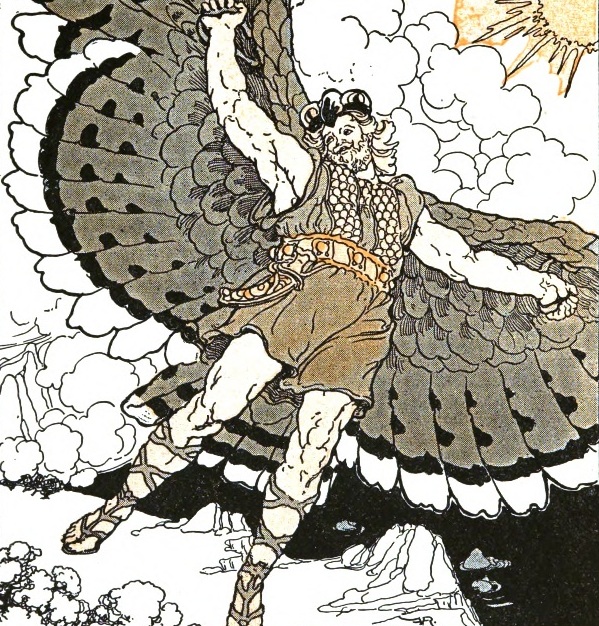 |
Frederick Richardson, 1913
The
astronomical quintessence therefore is:
At the setting of the Pleiades the
constellation Aquila is rising.
Interestingly Loki
crosses over the border Asgard and into Jötunheim in his search for the
hammer.
This border appears in several other stories (for example the Thjazi
myth, also connects Loki in the form of a bird of prey with Asgrindr,
the gate to Asgard). This border is identical to the Milky Way and
Aquila is located directly on it.
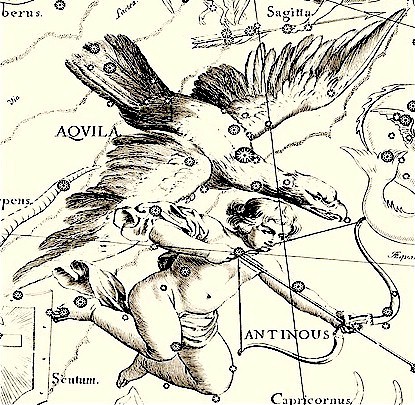
Aquila, Hevelius, Fimamentum, 1690
The second part of the poem deals with the circumstances leading to the reappearance of the hammer, i.e. the Pleiades and the killing of Thrymr, i.e. the setting of a constellation representing Thrymr. But where can we find the corresponding constellation? The key to its identification is the following stanza:
|
Þrymr sat á haugi, |
Thrym sat on a mound,
the giants' master, for his wolfhounds twisting golden leashes And brushing his mares' manes. |
This stanza has many
parallels to Skírnismál 11. This is one reason that some
scholars assume that both poems have the same author.
|
‘Segðu þat, hirðir, er þú á haugi sitr ok varðar alla vega: Hvé ek at andspilli komumk ins unga mans fyr greyjum Gymis?’ |
"Tell me, herdsman, sitting on the burial-mound, watching all the ways, How may I win a word with the maid past the hounds of Gymir? |
In both versions we find a man sitting on a mound speaking to the messenger. In Skírnismál we have the addition ‘guardian of all ways’. I associate this with the crossing of the Milky Way with the ecliptic and suggest that the guardian is the star Antares in Scorpio, one of the four royal stars of the sky (compare Antares)
I therefore would argue that Thrymr corresponds to Antares. To the same region points the connection to the hounds (‘greyum’, either Lupus or Scorpio or both) and the horses (‘mare’, Centaur and/or Sagittarius) appearing in both versions. Note that the horse in Skínismál is said to cross the vafrloga, the wafering-flame, another hint to the Milky Way on which Centaurus is standing.
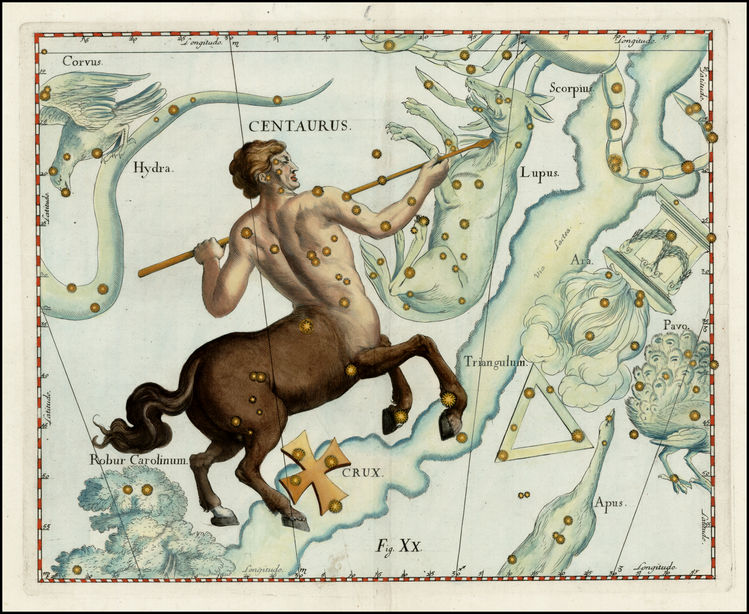
Centaurus on the Milky Way, Hevelius, Firmamentum 1690
This would be the second central statement of Thrymskvida:
The asterism of the Pleiades (the hammer)
reappears in the east at the time of the setting of the
Scorpio-Sagittarius-Centaur region (the home of the thursar).
As in Babylonian star lore it seems possible that the planets on their way on the ecliptic interfere with constellations and ‘occupy’ them. If we take the weekday-equation, Thor would be the planet Jupiter. Thrymskvida mentions explicitely that Thor is adorned with Freyja's necklace Brisingamen. Elsewhere, I have identified Brisingamen with the ring of stars forming the asterism of the Northern Fish of the constellation Pisces. This ring reaches into Andromeda and is another hint for the connection of Thor/Freyja with Andromeda.
THOR DRESSED AS A BRIDE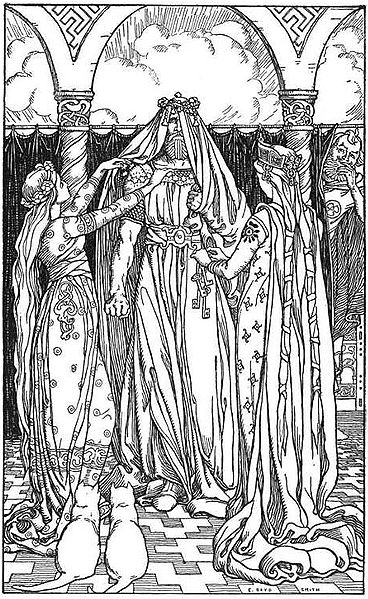 "Ah what a lovely maid it is!" Elmer Boyd Smith 1902 |
In Thrymskvida, Thor is dressed as a bride to
rescue his hammer Mjöllnir from the giant Thrymr who has stolen it. His dressing
is described in much detail. This might be of no further importance – however
there could also be a deeper sense in it. I already postulated that Thor dressed
as a bride refers to Andromeda, the famous bride of Perseus, placed in the sky
as a constellation. The details of the corresponding stanzas could indeed
support this theory:
| Bundu
þeir Þór þá brúðar líni ok inu mikla meni Brísinga, létu und hánum hrynja lukla ok kvenváðir um kné falla, en á brjósti breiða steina, ok hagliga um höfuð typpðu. |
18. They bound Thor in bridal linen and next the mighty Brisingsamen, 19. They let keys jingle about him and a woman's dress to fall at his knee, and on his breast broad stones, and a crown skillfully on his head. |
This could be compared to the description of Andromeda – the bride of Perseus— in Aratus' Phaenomena:
“[197] For there, too, wheels that woeful form of Andromeda, enstarred
beneath her mother. Thou hast not to wait for a night, I ween, whereon
to see her more distinct! So bright is her head and so clearly marked
are both the shoulders, the tips of her feet and all her belt. Yet even
there she is racked, with arms stretched far apart, and even in Heaven
bonds are her portion. Uplifted and outspread there for all time are
those hands of hers.”
“[205] Beneath her head is spread the huge Horse [Pegasus], touching her
with his lower belly. One common star gleams on the Horse’s navel and
the crown of her head.”
The head of the constellation Andromeda is formed by its brightest
star Alpheratz (Sirrah). Already in Aratus'
Phaenomena this star is
described as a crown.
This might explain the ‘hofud typpdu’ on top
of Thor's head. The necklace around his
neck might be the stars of the Northern Fish reaching into Andromeda and
having a circular structure. Aratus'
Phaenomena
says:
“Let the left shoulder of Andromeda be thy guide to the northern
Fish, for it is very near.”
The breast area is formed by the stars
δ-Andromedae
and τ-Andromedae
as depicted on many drawings.
The woman’s dress is hanging down to his knees
— maybe a hint to the star known as Adhil, the
‘Train of a Garment’, equivalent to the Greek ‘surma’ of Ptolemy. The
knees of Andromeda are explicitly mentioned by
Aratus:
“So the weary hands and knees and shoulders of Andromeda are
parted – stretched some below and others above the horizon, when the Two
Fishes are newly risen from the ocean.”
The keys that hang from his belt (the
stars Mirach, Vertex) might be connected to the Triangulum:
“[233] There is also another sign, fashioned near, below Andromeda, Deltoton [Triangulum], drawn with three sides, whereof two appear equal but the third is less, yet very easy to find, for beyond many is it endowed with stars.”
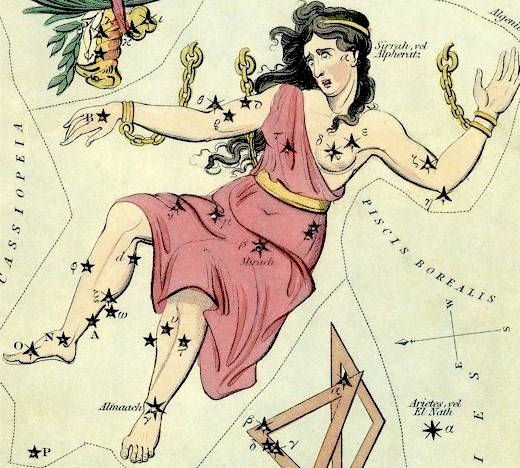
Andromeda, Urania's Mirror, 1825
A last detail I would like to mention is the assembly of the Aesir at the ‘thing-place’. This ‘thing-place’ appears in several Eddic stories and can be compared to the Sumerian constellation of ASH.IKU, ‘the Field’, known today as the Pegasus Square. This interpretation fits also smoothly into the astronomical concept:
After the return of Loki
(in the shape of the rising Aquila, the eagle) from Jötunheim (the Milky
Way as border) the Aesir have an assembly (rising of the Pegasus
square), Thor appears as a bride (Andromeda) with the necklace of the
Brisingamen (Northern Fish, Pisces) and finally the hammer (Pleiades)
reappears at the knee of Thor/Freyja (Andromeda) and Thrymr, his sister
and the thursar-folk is smashed (setting of the
Sagittarius-Scorpio-Centaur region).
